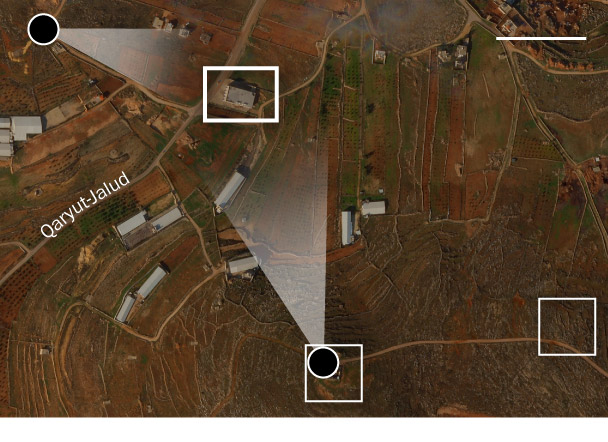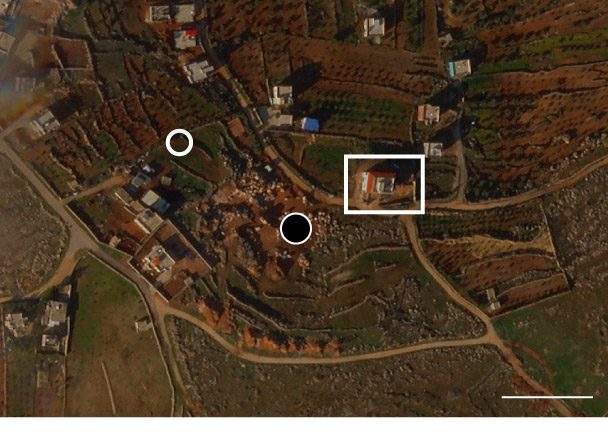
Exclusive
A review of the deadliest settler attack in the West Bank since the war began shows how increasingly violent tactics have gone unpunished
A Washington Post review of exclusive visuals of the attack, medical records and interviews with witnesses and first responders reveals that one of the Palestinians killed, 17-year-old Obada Saed Abu Srour, was shot in the back by settlers, probably as he was running from gunfire.
Israeli troops, meanwhile, did not forcefully intervene, despite their obligation under international and Israeli law to protect all residents of the West Bank, including Palestinians. Soldiers and police were photographed at the scene of the deaths only after the attack ended, even though troops stationed at nearby military outposts were within earshot of the gunfire and had views of an earlier attack by settlers, the visual evidence shows.
Abu Srour, the eldest of four children, with aspirations to become a policeman after finishing high school, was killed along with civil engineer and new father Muath Raed Odeh, 29. They were trying to protect the home of 30-year-old blacksmith Awad Mahmoud Odeh from attack. Musab Abdel Halim Abu Rida, 20, who worked in the fields and could always make his grandmother laugh, was killed near Abu Srour.
Awad Odeh’s home is one of the closest to Esh Kodesh, a small Israeli settlement just half a mile to the south. A steady drip of violence has persisted in Qusra and haunted his family for more than a decade. He watched a settler shoot and kill his father on the family’s farmland in 2017. Extremist settlers have vandalized and uprooted olive groves, physically attacked Palestinian farmers and harassed residents.
In the month after the Oct. 7 Hamas attack, more than 800 Palestinians were displaced from their West Bank homes amid increased violence by the radical Israeli settler movement, which has long held the aim of expelling Palestinians and expanding the Jewish footprint in the occupied territories. Between Oct. 7 and Jan. 4, more than 300 Palestinians were killed in the West Bank by Israeli troops or settlers, a dramatic increase in the rate of killing in the last months of 2023, the deadliest year since the United Nations began recording casualties in 2005.
The Israel Defense Forces (IDF) told The Post the incident is “under review” and the police have opened an investigation. Israeli Border Police said the incident is under “active investigation.”
Abu Srour’s mother, Aya, remembers warning him on that fateful day. “He said he wanted to go help. I told him there was no need,” she said. “He said, ‘If I die, I die — I would be martyred.’”
By the time Aya went back to check on her son, he was gone.
‘I didn’t expect to come out alive’
A shot fired by Palestinians toward Esh Kodesh around noon on Oct. 11 started the deadly chain of events, a message in a WhatsApp group run by settlers claimed the next day.
About 1 p.m., a group of masked settlers carrying firearms made their way into Qusra on all-terrain vehicles, according to Fouad Yasif Hassan, a Qusra resident and Red Crescent volunteer who was among the first to respond to the attack. Hassan told The Post that the settlers intentionally collided with a car in the area and began shooting at it.
More than a dozen Palestinians fled north to take cover behind a large building, away from gunfire that appeared to be coming from the direction of Esh Kodesh toward Qusra.
According to Hassan and local media reports, the masked settlers were firing mostly pistols and one M16, a popular military rifle. They left about 1:30 p.m. after shooting at several residents. Hassan said the Border Police and the army were in the area and cautioned residents not to attempt to stop the settlers. Only the police, Israeli officials told the village’s residents, were allowed to confront the settlers.
Israeli soldiers stationed at two military outposts that sit between the settlement and the village would have had clear views of the road on which residents were fleeing and the building they hid behind, visual evidence shows.

Building used for shelter
Israeli
military
outposts
Satellite © Planet Labs 2023

Building used for shelter
Israeli
military
outposts
Satellite © Planet Labs 2023
An Israeli official with knowledge of the Oct. 11 incident, who spoke on the condition of anonymity because he was not permitted to speak publicly, said soldiers heard sounds of gunfire coming from the village and left the outpost. He said soldiers reported the incident and then saw “friction” between settlers and Palestinians in the area. They called for other forces, who came and separated the groups.
But the conflict that day continued. About 3 p.m., settlers gathered outside Awad Odeh’s home, about a half-mile from the first attack. Six armed and masked settlers tried to break into the home’s front gate while Odeh, his mother and three young children sheltered inside, according to photos, Odeh and witness accounts.
“I saw on the [security] cameras there were settlers around our home destroying cars and shooting at windows,” Odeh said. “We hid in the house and they tried to get in, and they shot and swore at anyone they saw.”
Odeh moved to the roof of his house and threw rocks at the settlers, who started throwing rocks back and shooting at him.
“As soon as we got 10 to 15 meters out of our home, they shot at my family and injured my daughter, and I got shot right after,” Odeh said. “It was like an action movie. I didn’t expect to come out alive. I’ve never been in a position like this.”
His cousin Muath Raed Odeh ran into the house to try to save Awad’s 6-year-old daughter, said a witness who spoke on the condition of anonymity for fear of reprisals. Muath was shot and later died at a hospital.
Other Palestinians fled and dived for cover amid the barrage of gunshots. Abu Srour, the 17-year-old, was among those who didn’t escape. His body was found facedown atop a hillside near the house he was trying to defend.
Abu Srour was shot in the back, according to a photo and his medical records, which revealed that the bullet “exited from the upper middle of the chest,” causing “bleeding and destroying the lungs.”
At 3:40 p.m., a local Arabic-language Telegram channel, Nablus News, reported that three people had been killed in Qusra.

Location of
Obada Saed Abu Srour’s body
Satellite © Planet Labs 2023

Location of
Abu Srour’s body
Satellite © Planet Labs 2023
Under Israeli and international law, Israeli soldiers have an obligation to protect Palestinian residents of the West Bank. Israeli military orders specifically state that soldiers must prevent crimes such as manslaughter and deliberate damage to property.
“We, as a military soldier, sovereign, the occupier, must protect Palestinians from settler violence,” said Ori Givati, the advocacy director of Breaking the Silence, an organization of veteran soldiers that compiles research and testimonies about events in the occupied territories.
The failure of police and the army to respond effectively to the violence on Oct. 11 is clear from the evidence collected by The Post and shared with forensics and legal experts.
Michael Sfard, a prominent human rights lawyer in Israel who reviewed the evidence, said he has worked on hundreds of settler violence cases and calls this pattern of inaction — in which soldiers and officers witness an attack and fail to intervene — “standing idly by.”
In practice, “there has been a serious problem of implementing the law,” said Roni Pelli, a lawyer with the Association for Civil Rights in Israel, who also reviewed the Oct. 11 evidence. “There’s no doubt that [the Israeli army] should have stopped it. They should have detained [the settlers] until the police comes and take them.”
The gunshots were from pistols, according to audio forensics expert Steven Beck, who reviewed a Facebook Live video that captured the firing. Several settlers were seen carrying pistols that day.
Beck and other audio forensics experts said the sounds of the gunfire were probably audible at the two military outposts, less than half a mile away.
The Israeli official with knowledge of the incident said Israeli forces saw a vehicle leaving Qusra with “four individual settlers,” each with their “face covered.” At the same time, the forces received reports of dead and wounded Palestinians inside the village. The official said that no Israeli soldiers were at the scene when the fatal shootings took place but that they scanned the area for evidence afterward, finding bullet casings consistent with 9mm handguns.
The first available visual evidence verified by The Post of Israeli security forces came about 4 p.m., when they were photographed removing surveillance footage from Awad Odeh’s home and handing it to Border Police officers.
The Post requested access to the surveillance footage. The police declined, citing the open investigation.
Qusra residents pointed to the IDF’s removal of the surveillance footage immediately after the attack as evidence of culpability. “[The authorities] came to take the DVR to hide their atrocities. They had to hide it,” Odeh said.
The Israeli official who spoke on the condition of anonymity said of the settler attack: “Authorities in general have received intelligence, including from security forces on the ground, regarding the identities of the people who committed that crime but the authorities did not have prior knowledge of their identities.”
The official said the attackers were not part of the Esh Kodesh civil defense squad — a unit of settlers that has been armed and trained by the military and operates under its supervision. Nor, he said, were they IDF reservists. The Esh Kodesh civil defense squad, which was near Qusra on Oct. 11 alongside IDF soldiers, declined to comment.
Residents of Esh Kodesh declined to comment on the violence in Qusra that day, referring questions to a lawyer. He did not respond to requests for comment.
Police said they arrested a 22-year-old resident of the Esh Kodesh area on Nov. 7 on suspicion of murder. A person with knowledge of the case, who spoke on the condition of anonymity for fear of retribution, told The Post the arrest was linked to the Oct. 11 attack.
The 22-year-old was held for about 20 minutes of questioning and then released on a restraining order prohibiting him from going to two Palestinian villages and from contacting 22 individuals, according to local media reports and confirmed by The Post. Police declined to say whether they recommended charges for anyone involved in the Oct. 11 attack. The Post could not identify any others who faced arrest or prosecution.
Abu Srour’s mother, Aya, says she has just one regret about that day. “I wish that in the last moment, he came to me, I embraced him. That’s it.”
Imogen Piper in London, Jarrett Ley and Jon Swaine in New York, Wahaj Bani Moufleh in the West Bank, Ala Aladdin in Washington and Jonathan Baran in San Fransisco contributed to this report.

